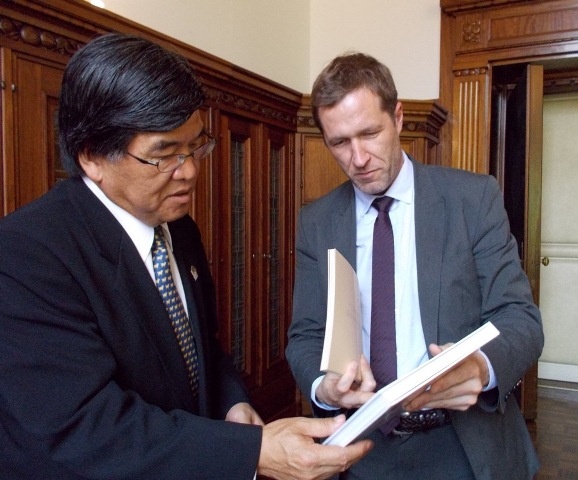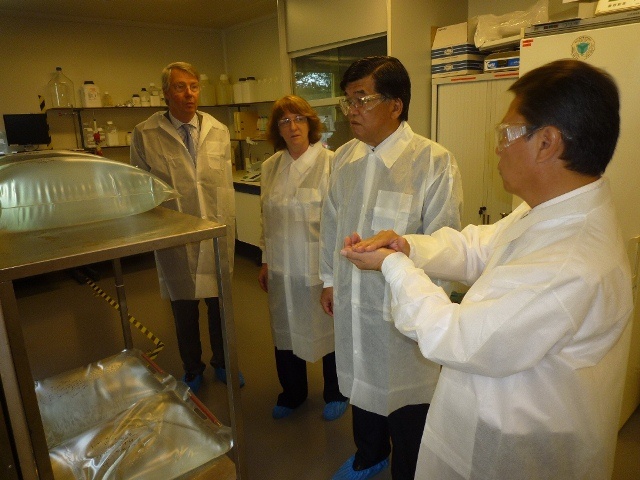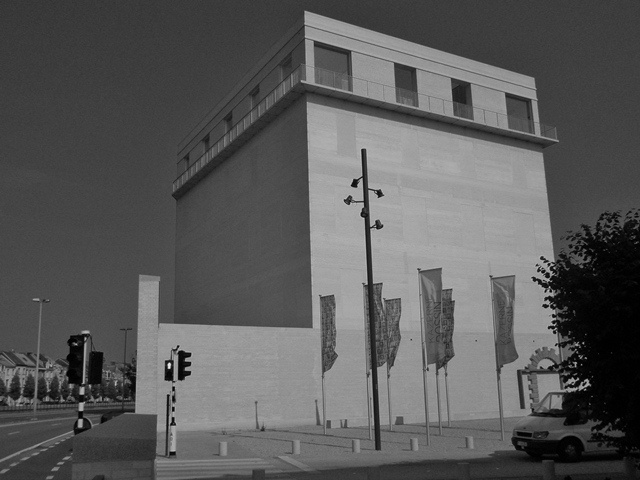The Belgian National Day and Enthronement of the New King (No.24)
July 21st is National Day in Belgium. It was a special National Day this year, the day before yesterday. On this day, His Majesty King Albert II, who reigned for 20 years, abdicated and His Royal Highness Crown Prince Philippe was sworn in as the new king. It is the first time in the royal history of Belgium that the king abdicated voluntarily. The reason for the abdication seems to be his advanced age of 79 and health reasons, not permitting him to fully fulfil his duties as a king. The new king is the 7th king of Belgium and 53 years old and Her Majesty Queen Mathilde is 40 years old. They have four children; the eldest is Princess Elisabeth (11 years). The new king has a younger sister, Princess Astrid, 51 years old and a younger brother, Prince Laurent, 49 years old. The image of the Belgian Royal Family has greatly changed. His Majesty King Philippe has visited Japan several times when he was still Crown Prince. His most recent visit to Japan was last year in June, leading a big economic mission of about 300 members. Although I had greeted “Crown Prince Philippe” on the occasion of diplomatic corps receptions, seeing the new “King” up close at the Te Deum in the Saint-Michel Cathedral and at the military parade in front of the Royal Palace in Brussels on the 21st of July, I felt as if His Majesty bore himself with even more dignity. I hope that the exchanges with our Imperial Family will be further deepened and that the relationship between Japan and Belgium will be developed even more all through the time of His Majesty King Philippe.
< The first Belgian King who came from Germany >
Prince Leopold from the House of Saxe-Coburg-Gotha was summoned to be the first King of Belgium and was crowned on July 21st 1831. The reason why a German Prince was invited to the new state of Belgium is not very well known. In particular since the House of Saxe-Coburg-Gotha is a branch of the House of Wettin, one of the Saxon Duchies, it might be all the more surprising in the eyes of Japanese people. In fact, in Belgium, which had just gained independence from the Netherlands, there were so many opinions about who should be the new king that the situation was thrown into confusion. At the same time, the “July Revolution” broke out in France, Charles X fled abroad and the “Vienna Regime” (1815) after the Napoleonic wars was on the brink of collapse. Therefore an international conference was held by the major European powers in London in 1830: the constitutional monarchy France with its new King, Louis-Philippe d’Orléans, the United Kingdom, Russia and others got together to discuss problems such as the new independent state of Belgium and the national polity of Greece. However, the interests of the Great Powers, wanting to have influence on the new independent states in the future, clashed fiercely. Eventually, a compromise between the United Kingdom and France was found by making Prince Leopold of the House of Saxe-Coburg-Gotha, who was closely related to the British Royal Family, the King of Belgium and by having the new King marry the daughter of King Louis-Philippe of France. Russia was dissatisfied with this and did not recognize the independence of Belgium, but because the Belgian delegation accepted King Leopold during their visit in London, the matter was settled.
In the first place, the House of Saxe-Coburg-Gotha was closely connected with the Great Powers of Europe, especially the Hanoverian Dynasty of Britain (German lineage). One of Duke Franz’s (reigned from 1800 to 1806) daughters married the Duke of Kent of Britain and their daughter would accede to the throne of Britain as Queen Victoria (in 1840 the Queen would marry Prince Albert of the same House). One of Duke Franz’s sons married Portuguese nobility and the next generations married into the royal families of Portugal and Bulgaria. And, closely related even to Russia under the reign of Empress Ekaterina II, the House of Saxe-Coburg-Gotha was a prestigious noble family. Prince Leopold himself had won fame by fighting against Napoleon as a young general in the Russian army and had married Princess Charlotte (a cousin of Queen Victoria), the daughter of the Prince Regent of Britain (later King George IV) (the Princess died following childbirth two and a half years after their marriage). Connoisseurs would know that Prince Leopold was also a candidate to be king of the new Greece. It is no wonder that he was recommended as the King of Belgium in the European upper classes in those days. It should be noted that the House of Saxe-Coburg-Gotha is the result of a personal union (1826) between the House of Coburg(the current Bavaria) and the House of Gotha (the current Thüringen), both having made up the Saxon Duchies. It is a very complex story.
< Charleroi and the Socialist Party >
 Charleroi, the fourth largest city (202.300 inhabitants) in Belgium, is located 60 km to the south of Brussels. I visited the city the other day and met with the mayor, Mr. Paul Magnette. Only 41 years old, he is the chairman of the Walloon Socialist Party and until recently he served as Minister for Public Enterprises, Scientific Policy and Development Cooperation in the government. As mayor of Charleroi, he would like to strengthen economic activities in the field of research and development, biotechnology and transportation (logistics). In relation with Japan, Japanese companies such as AGC Glass Europe have a manufacturing site in the region and the sister city relationship with the city of Himeji in Japan since 1965 seems also important. In fact, a large model of Himeji Castle, designated a World Heritage Site by UNESCO, is on display near the entrance of the mayor’s office. He told me that a few days later 8 students from Himeji would arrive for a homestay. Charleroi, the fourth largest city (202.300 inhabitants) in Belgium, is located 60 km to the south of Brussels. I visited the city the other day and met with the mayor, Mr. Paul Magnette. Only 41 years old, he is the chairman of the Walloon Socialist Party and until recently he served as Minister for Public Enterprises, Scientific Policy and Development Cooperation in the government. As mayor of Charleroi, he would like to strengthen economic activities in the field of research and development, biotechnology and transportation (logistics). In relation with Japan, Japanese companies such as AGC Glass Europe have a manufacturing site in the region and the sister city relationship with the city of Himeji in Japan since 1965 seems also important. In fact, a large model of Himeji Castle, designated a World Heritage Site by UNESCO, is on display near the entrance of the mayor’s office. He told me that a few days later 8 students from Himeji would arrive for a homestay.
Charleroi used to be called the “gold rush town” and although it is a big city with a subway and even an international airport on the outskirts, the odd thing is that the number of luxury hotels and restaurants is very small and, unlike other cities in Belgium, no big church can be found in the city centre. Charleroi flourished in the 19th century and many immigrants from abroad gathered there to work in the coal mines, thus supporting the Belgian industrial revolution. After that, the steel and glass industry prospered and even today many factories of construction machinery and electrical machinery and chemical and pharmaceutical factories stand in a row. In Marcinelle, a district south of the city centre, you will find the “Espace du 8 août”. The place is named after the date that the worst coal mine accident in the history of Belgium occurred in 1956 as to never forget what happened that day. The death toll rose to 262 people, most of them Italian immigrants. On the same site, the remains of the mine called “Bois du Cazier” and a Memorial have been preserved. What is interesting is the birth of a group of renowned strip cartoonists called the “School of Marcinelle” in the middle of the 20th century here. This was a group of writers that worked together on the popular cartoons of the local newspaper “Spirou” in those days. Even today, the images of the main characters of these comic strips are on display on the roundabouts in the city centre. “Coal and comics”, it is quite a strange combination.
< Eurogentec, a Leading Japanese Biotechnology Company >
 Beginning of this month, I paid a visit to the Japanese biotechnology company called Eurogentec, located in the Science Park on the outskirts of Liège (100 km east of Brussels). This company was established as a spinoff of the University of Liège in 1985 and has developed into a cutting-edge company that manufactures life science-related products such as bioresearch reagents and medicine screening. In 2010, the Japanese Kaneka became the parent company, holding 70% of the shares. At present, there are 390 employees of which 230 people work in Liège. 90 % of the products are exported to countries such as France and the United States and annual total sales reach about 44 million euro. I had a one-hour guided tour of the company: each department is divided by partitions and researchers in white coats are coming and going quietly, so rather than a factory, Eurogentec feels like a research laboratory. The production process of bio reagents such as synthetic DNA and antibodies is very technical and not easy to understand for a layman like me. Only the facility where microorganisms are cultured is somewhat big, but because there was an offensive smell I could barely understand what they were doing there. At the lunch table after the visit, I asked several members of the senior staff “whether the corporate environment had changed after coming under Kaneka’s umbrella” and I got positive feedback from everyone. There are quite many examples of major Japanese enterprises acquiring local companies in Belgium and when they are managed well, I feel relieved and pleased at the same time. Beginning of this month, I paid a visit to the Japanese biotechnology company called Eurogentec, located in the Science Park on the outskirts of Liège (100 km east of Brussels). This company was established as a spinoff of the University of Liège in 1985 and has developed into a cutting-edge company that manufactures life science-related products such as bioresearch reagents and medicine screening. In 2010, the Japanese Kaneka became the parent company, holding 70% of the shares. At present, there are 390 employees of which 230 people work in Liège. 90 % of the products are exported to countries such as France and the United States and annual total sales reach about 44 million euro. I had a one-hour guided tour of the company: each department is divided by partitions and researchers in white coats are coming and going quietly, so rather than a factory, Eurogentec feels like a research laboratory. The production process of bio reagents such as synthetic DNA and antibodies is very technical and not easy to understand for a layman like me. Only the facility where microorganisms are cultured is somewhat big, but because there was an offensive smell I could barely understand what they were doing there. At the lunch table after the visit, I asked several members of the senior staff “whether the corporate environment had changed after coming under Kaneka’s umbrella” and I got positive feedback from everyone. There are quite many examples of major Japanese enterprises acquiring local companies in Belgium and when they are managed well, I feel relieved and pleased at the same time.
< The Holocaust and Belgium >
 Last week, I had the opportunity to talk with an executive of the World Jewish Congress, residing in Belgium, and I learned that there are currently about 30.000 Jews living in Belgium (1000 in Japan). We talked about the “Holocaust and Human Rights Museum”, commemorating the massacre of Jews during World War II, that was opened last November in the city of Mechelen (30km north of Brussels; 80.000 inhabitants). More than 67 years after the war, many people might think “why now”? There are many “Holocaust Museums” all over the world and Japan is no exception to this. However, the situation in Belgium is quite complicated and the horrid memory of the Holocaust is part of its history. That’s why I think that this museum could have been opened only now when not many people that lived in that period and were involved are left. The truth of the genocide of the Jews was recognized at the Nuremberg Trials in 1946 and it became increasingly clear that many Jews were deported to concentration camps from Belgium as well. At that time there were 50.000 to 60.000 Jews living in Belgium, but nearly half of them (25.484 people according to the museum’s data) were brought to the transit camp of Mechelen before being deported by train to the concentration camp of Auschwitz. Many people were actively involved in the mass murder of the Jews in German-occupied Belgium and after the war it became a hideous memory that one does not want to remember. When I visited this museum end of last year, covered in light rain, there were not many visitors and the museum was deserted with only some articles left behind by Jews on display. Holding my umbrella, I stood still for a while in front of this museum and I understood that this might be a way of showing the Belgian conscience that the Holocaust should never be forgotten. Last week, I had the opportunity to talk with an executive of the World Jewish Congress, residing in Belgium, and I learned that there are currently about 30.000 Jews living in Belgium (1000 in Japan). We talked about the “Holocaust and Human Rights Museum”, commemorating the massacre of Jews during World War II, that was opened last November in the city of Mechelen (30km north of Brussels; 80.000 inhabitants). More than 67 years after the war, many people might think “why now”? There are many “Holocaust Museums” all over the world and Japan is no exception to this. However, the situation in Belgium is quite complicated and the horrid memory of the Holocaust is part of its history. That’s why I think that this museum could have been opened only now when not many people that lived in that period and were involved are left. The truth of the genocide of the Jews was recognized at the Nuremberg Trials in 1946 and it became increasingly clear that many Jews were deported to concentration camps from Belgium as well. At that time there were 50.000 to 60.000 Jews living in Belgium, but nearly half of them (25.484 people according to the museum’s data) were brought to the transit camp of Mechelen before being deported by train to the concentration camp of Auschwitz. Many people were actively involved in the mass murder of the Jews in German-occupied Belgium and after the war it became a hideous memory that one does not want to remember. When I visited this museum end of last year, covered in light rain, there were not many visitors and the museum was deserted with only some articles left behind by Jews on display. Holding my umbrella, I stood still for a while in front of this museum and I understood that this might be a way of showing the Belgian conscience that the Holocaust should never be forgotten.
|